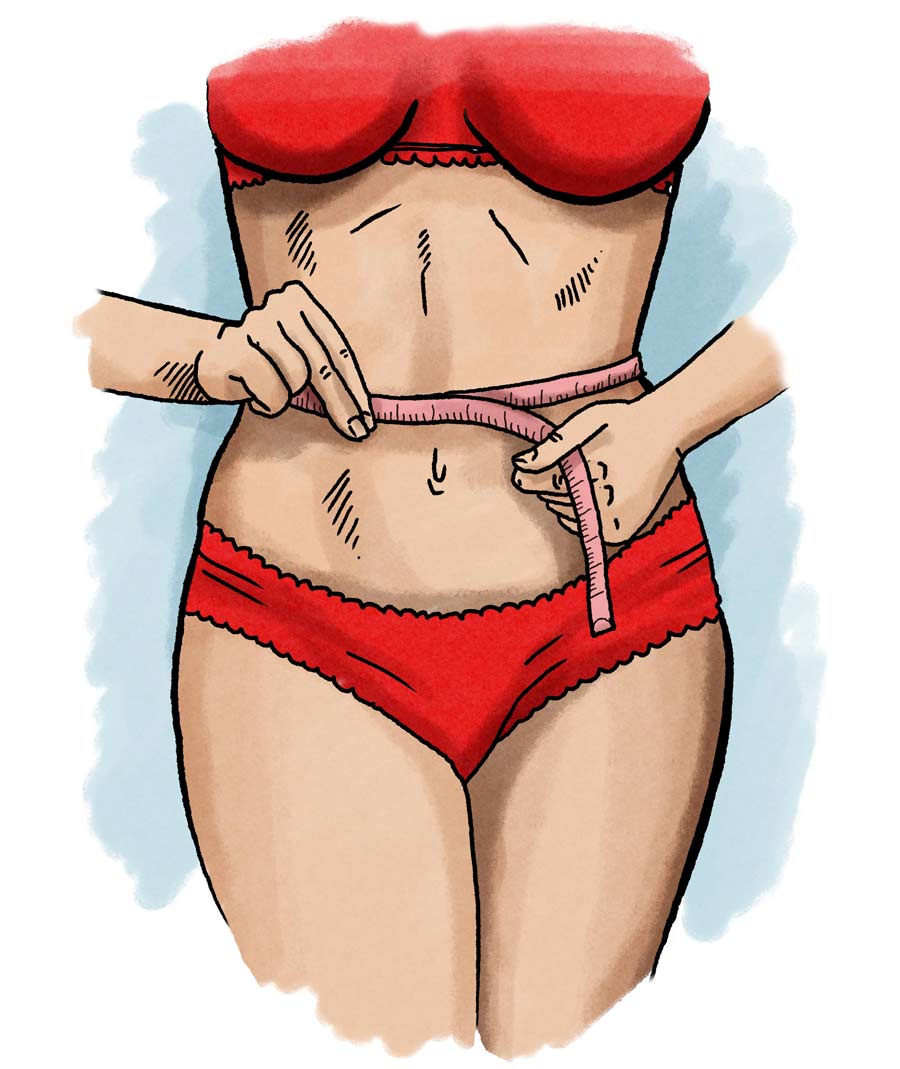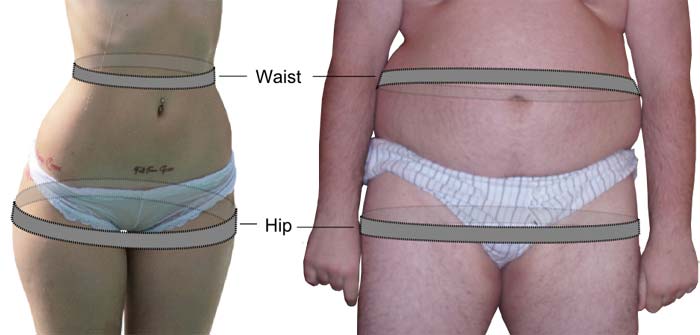6 Alternatives to Body Mass Index (BMI)
BMI is, at its most basic, a calculation of the relationship between your height and weight. A higher Body Mass Index typically indicates a higher level of body fat, although it does not distinguish between muscle and fat.
Many doctors and healthcare professionals continue to use BMI as a guide when they are assessing the general health of patients. However, the method, which has been in use since the 1840's, has some notable weaknesses.
The first problem is that it doesn't provide an accurate estimate for the percentage of body fat. Another problem is that men and women can have the same body fat percentage but different BMI readings. Finally, people who carry a lot of muscle mass can receive an inaccurate BMI reading that suggests they are overweight or obese when they are not.
Feeling confused about what to think? Don't worry! There are alternatives to BMI. In fact, combining one or more of the methods below can give you a more accurate indication of how much body fat you are carrying. Let's dive in...
1) Body Adiposity Index (BAI)
BAI is unlike BMI as it doesn't use your weight in the calculation. In order to work out your percentage body fat, BAI multiplies your hip circumference by your height.
Initially, BAI was thought to give a more accurate assessment of body fat than BMI, particularly because it accounts for fat distribution. However, recent research has indicated that while BAI can be useful, it does tend to overestimate body fat, especially in certain populations. 1
Studies have shown that BAI may be less accurate than methods like air displacement plethysmography (e.g., Bod Pod) or dual-energy X-ray absorptiometry (DXA). Because of this, BAI may not be the best standalone tool for assessing body fat. With that said, it can still be useful in environments where scales may not be available, such as the jungle or desert. 2
2) Waist Circumference Measurement
One of the most effective alternatives to BMI uses an item most people have at home - the simple and humble tape measure. Measuring your natural waist gives you a good indication of the amount of abdominal fat you are carrying, which is strongly linked to health risks.
Knowing your waist circumference can help you understand whether you're above the thresholds that signal an increased risk of conditions such as heart disease and type 2 diabetes. 3
According to medical guidelines, these measurements indicate people who are in the 'at-risk' category: 4
- Women: A waist circumference of 35 inches or more (88 cm)
- Men: A waist circumference of 40 inches or more (102 cm)
How to measure your waist circumference
To take a waist circumference measurement, you should place your tape measure midway between your lowest rib and the top of your hips - it should be the part just above your belly button. Don't suck your stomach in: you've got nothing to gain from an inaccurate calculation. Gently breathe out and measure with the tape pulled snugly against your skin, though not digging or pulling in. Make sure the tape sits flat all the way around, as diagonal slippage will falsely increase the measurement.

Your measurement gives you an estimate of something called visceral fat, which is a key indicator of your risk for obesity-related health issues.
3) Waist-to-Hip Ratio
The waist-to-hip ratio is not only an excellent way of calculating how much excess weight you are carrying, it can also be used to indicate susceptibility to a number of health issues, including high blood pressure, heart disease and diabetes.
How do you calculate your waist-to-hip ratio?
Using a tape measure, take a reading from your natural waist line and the widest part of your hips. Now divide the circumference of your waist by your hip circumference measurement. Once you've done that, compare to our results chart below.

Image credit: Mikael Häggström.
Waist-to-hip ratio results chart
The figures in the waist-to-hip chart below represent different risk levels and are based upon guidelines from major health organizations such as the World Health Organization (WHO) and other reputable sources. 5
| Category | Men | Women |
|---|---|---|
| Low Risk | < 0.95 | < 0.80 |
| Moderate Risk | 0.96 - 1.0 | 0.81 - 0.85 |
| High Risk | ≥ 1.0 | ≥ 0.86 |
According to the National Institutes of Health (NIH), the World Health Organization (WHO) defines abdominal obesity as a WHR of more than 0.90 for men and more than 0.85 for women. These widely referenced standards are used to predict health risks associated with obesity more accurately than BMI alone. 6
4) Waist-to-Height Ratio (WHtR)
Another effective BMI alternative for the toolbox is the Waist-to-Height Ratio (WHtR). Calculating your WHtR involves taking your waist measurement (using the instructions from above) and then dividing it by your height. Just make sure that your measurements are in the same unit (inches, cm, etc).
If the result of your calculation is 0.5 or higher, it could be a red flag, indicating a higher risk of heart disease, type 2 diabetes, and other obesity-related conditions.
Let's try an example:
Imagine you have a waist circumference of 32 inches and you stand 64 inches tall. To find your WHtR, you simply divide your waist measurement by your height. So, in this case, it's 32 divided by 64, which gives you a WHtR of 0.5, indicating you're right at the threshold. As you can see, it's a quick calculation, but it can tell you a lot about your health.
Recent research, like a study published in BMJ Open, has shown just how powerful WHtR can be as an early warning system for health risks, especially those tied to belly fat. The study found that people with a WHtR over 0.5 were flagged as being at higher risk more effectively than when using the traditional BMI and waist circumference methods. 8
5) Hydrostatic Weighing
Contrary to popular belief, hydrostatic weighing is an effective way of calculating body fat. The weighing process takes place underwater on a chair that is placed on a zeroed-out set of scales. You then sit on the chair before exhaling all the air from your lungs and then placing your head underwater. Once the scales stabilise, your weight is taken. The resulting figure is then passed through a series of formulas that ultimately produce a body-fat reading.
Hydrostatic weighing works on a simple idea: fat tissue is less dense than water, which makes your body float, while muscle, being denser, causes you to sink. By comparing your weight on dry land with your underwater weight, technicians can figure out your body density and use that to estimate your body fat percentage. Clever, eh?
Even though this method is highly accurate, it does come with a few downsides. Firstly, the process can be a bit uncomfortable and unpleasant, since it involves fully submerging yourself and exhaling all the air from your lungs. And then there's the cost. Hydrostatic weighing can be quite expensive, depending on where you go, because it requires specialized equipment. So, it's usually only available in research settings or specialized clinics.
Drawbacks aside, hydrostatic weighing can be a solid choice for those who want a precise measurement of their body fat and have access to the right resources.
You can read more about hydrostatic weighing in this Healthline article.
6) Body Fat Measuring
Probably the simplest way to calculate your body fat is by using a special set of callipers. Skin and fat measurements are taken from the waist, shoulder blade, biceps and triceps. The resulting readings, in millimeters, are added up to produce a single figure. The figure is then plotted against a chart that takes the patient's sex, age and measurement into consideration to determine the body-fat percentage figure. The higher the body fat, the higher your risk of suffering from obesity-related conditions.
While caliper measurements are a handy and widely available way to check body fat, their accuracy really hinges on the skill of the person using them. It's crucial that the calipers are placed just right, consistently hitting the correct spots with the right technique. Usually, measurements are taken from three to seven different points on the body to make sure you're getting a true picture of your body fat.7
While this method is practical for everyday use, it might not be as accurate if someone has a higher level of body fat or a BMI over 35. This is because calipers can sometimes miss the full thickness of the fat layer. However, putting that limitation to one side, using calipers to measure body fat can be a budget-friendly way to keep track of changes in your body composition over time.
Final Thoughts
As we discussed at the top of our article, BMI is widely used, but it doesn't necessarily provide a complete picture of your health. That's where other measurements such as Waist-to-Hip Ratio, Body Adiposity Index, and Waist-to-Height Ratio come in, giving you additional information about how fat is distributed in your body.
As always, if you are concerned about your weight or want advice on the best approach for you, it's wise to speak to a Doctor or health professional for advice and guidance.
References
- A new anthropometric index for body fat estimation in patients with severe obesity. BMC Obesity
- Body Adiposity Index, Body Mass Index, and Body Fat in White and Black Adults. JAMA
- Waist size predicts heart attacks better than BMI, especially in women. American Heart Association (AHA)
- Factors Affecting Obesity and Waist Circumference Among US Adults. CDC
- What Is the Waist-to-Hip Ratio?. Healthline
- Practical Guide to the Identification, Evaluation and Treatment of Overweight and Obesity in Adults. NIH
- Additional Measures of Body Fat Measurement. Harvard T.H. Chan School of Public Health
- Waist-to-height ratio as an indicator of 'early health risk'. BMJ Open. 2015
